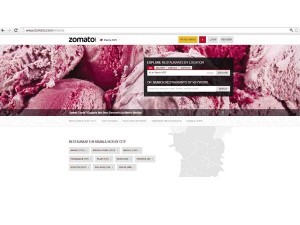Filipinos love to go online and they love to eat.
Add the fact that most Filipinos speak English and the result is a very viable market where a website like www.zomato.com, that can help Filipinos decide what new restaurant to try or promotions to avail themselves of, can make a decent profit.
According to Zomato founder and CEO Deepinder Goyal, the company had long wanted to expand to the region from its base in New Delhi, and the Philippines emerged as the logical starting point.
“We have been focusing on increasing our reach beyond India over the last one year and wanted to expand into Southeast Asia, as it is a big market for a product like ours. The choice for our next market launch was between the Philippines and Bangkok. However, we found the Philippines to be a bigger market and since Zomato is currently available only in English, we decided to go with the Philippines first,” Goyal tells SundayBiz.
Zomato is reputedly the world’s largest online restaurant and nightlife guide and it launched its Metro Manila section on March 21. It was started in July 2008 and has since expanded to 21 cities across India, the United Kingdom, United Arab Emirates, Sri Lanka, Qatar, South Africa and the Philippines.
Www.zomato.com is a guide that provides in-depth information on over 95,900 restaurants in countries where it is present. Other features include reviews, ratings and ability follow other users’ recommendations in Zomato. Aside from the website and the apps, Zomato is also available in print in some cities in India. It claims a monthly user base of over 15 million and these provide a big enough market to attract advertising revenue.
For Zomato, the Philippine market is big enough to support a specific page.
“When we sent our team to Manila, we noticed that smartphone penetration in the Philippines is very high and given the fact that the Philippines is a very cosmopolitan country that loves to eat, it made for a perfect market for a product like ours. The phenomenal response we received in Manila in just a few months since we launched, has reinstated our belief and our resolve to expand our services further into Southeast Asia in the months to come,” says the Mathematics and Computing graduate of IIT Delhi.
“We already have an office in Manila with a staff strength of 10 and will be hiring more in the months to come. We are currently focusing on garnering stellar content on the website, especially user reviews, after which we will work on the print version of Zomato Manila,” adds Goyal, who got the idea to put up Zomato when he saw the demand for menu cards among his former colleagues at Bain and Company in New Delhi.
Zomato is bent on constantly improving the content on the website as that is the only reason why people will continue the use the site. And as the number of users increase, the advertising money will increase correspondingly.
“Content is our strongest point. To ensure quality, we collect and curate all our data (apart from reviews and ratings) ourselves, and refresh all of it every three months. All this is accessible to users on a clean and simple interface across mediums, which is our key differentiator and enables users to get what they want in three simple steps. Users can also access Zomato wherever they are—be it online or on their smartphones. Our focus throughout everything is to be a reliable source for the user. Even our social features have been implemented keeping in mind our everyday interactions with friends about places or dishes to eat. All these factors together contribute to the success we have enjoyed so far,” says the former management consultant.
To drive people to its website and catch the fleeting attention of netizens, Zomato, which was developed in 2008 out of Goyal’s apartment, also invests in below the line marketing such as in-restaurant branding. Being active on social media also helps attract people to the website. It even runs contests and engaging activities such as the #FoodieFriday quiz on Twitter, and the Instagram contest on the website to keep in touch with the users.
“Overall, we make sure our product reaches as many people as possible, without having to spend unreasonable amounts of money. The focus is on building brand loyalty and good word of mouth, which in itself helps bring a lot of people to Zomato,” says Goyal, who remains responsible for strategy and product development.
He estimates that over 15 million users visit Zomato just before lunch or dinner to help them decide where to eat or order from.
“This forms a highly targeted platform for players in the food and beverage sector to promote their product. Even though all listings on Zomato are free of charge, advertisements are paid for,” he says.
And the work to improve the website never ends.
According to the 30-year-old Goyal, Zomato is always looking to add more features to enhance the experience for the users. And many of these are location-specific as well.
“For example, in Dubai we have added filters for users to find sports bars, or restaurants serving sheesha, as these are very popular there. We are also working on building the website in other languages for more users to be able to access it. Given that our website has also become a social network of sorts for foodies, we are working on adding more features to create a stronger social experience for users who write a lot of reviews,” he says.
The work has just begun but Zomato believes that with the success so far, it is on the right track to winning the hearts and clicks of Filipino foodies.



